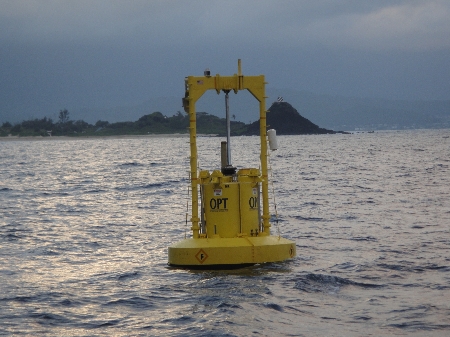Understanding the Effects of Ocean/Tidal/Stream Power
March 29, 2011
Generating electricity from river currents, ocean waves and tides is a budding industry with great promise. The Earth’s oceans and rivers could supply us with a lot of clean energy, in theory.
Wave energy technologies developed by Aquamarine Power, Ocean Power Technologies and Pelamis Wave Power are ready for commercial operation, said Tim Mundon, a senior engineer for Kleinschmidt Associates.
“There are a number of devices that really are at a high technology readiness level,” Mundon said recently during the Renewable Energy World North America Conference & Expo in Tampa, Fla.
Still, hydrokinetic energy devices are largely unproven and require extensive testing, especially to determine their effect on the environment.
 In
a report to Congress, the U.S. Department of Energy identified
the potential environmental effects of hydrokinetic energy
devices that need further monitoring and testing. The report
also identified ways to mitigate the adverse environmental
effects related to the installation and operation of
hydrokinetic projects.
In
a report to Congress, the U.S. Department of Energy identified
the potential environmental effects of hydrokinetic energy
devices that need further monitoring and testing. The report
also identified ways to mitigate the adverse environmental
effects related to the installation and operation of
hydrokinetic projects.
An article summarizing the findings of that report can be found in the April issue of Hydro Review magazine.
Among other things, the report points to concerns about installation, electromagnetic fields, spinning turbines, accidental leaks and changes in currents and waves. All of these could alter migration paths, transform beaches and bays, injure marine life, disturb the seabed and diminish food availability.
But the effects are “mostly speculative” because few devices have actually been deployed and tested in rivers and oceans in the U.S. For some environmental issues, “the potential effects will prove minor and not require extensive investigation,” the report found.
The report encouraged the use of adaptive management principles in the licensing of hydrokinetic projects. This would require the developer to adjust the project to mitigate any unacceptable environmental effects.
The DOE is funding several efforts to assess the environmental effects of hydrokinetic projects and to improve the siting of such projects.
But more support for research and assessment in the U.S. is needed. The U.S. is far behind the UK in the development of hydrokinetic power. The UK has plans to install 300 MW of new hydrokinetic capacity in the next five years while the U.S. plans to install 50 MW during the same period, according to IHS Emerging Energy Research.
The technical potential of ocean wave power in the U.S. is 90,000 MW, according to estimates by the Electric Power Research Institute. If the U.S. adopted a national renewable electricity standard of 25 percent, more than 13,000 MW of that potential could be realized by 2025, according to a study by Navigant Consulting
Russell Ray is senior editor of Hydro Review magazine. Russell has 11 years experience as an energy journalist, covering the oil and gas industry in Oklahoma and the growth of solar and nuclear power in Florida. He served eight years as the energy reporter for the Tulsa World. He held the same position at the Tampa Tribune for two and a half years before joining Hydro Review in 2009.
The information and views expressed in this blog post are solely those of the author and not necessarily those of RenewableEnergyWorld.com or the companies that advertise on this Web site and other publications. This blog was posted directly by the author and was not reviewed for accuracy, spelling or grammar.
 To subscribe or visit go to:
http://www.renewableenergyaccess.com
To subscribe or visit go to:
http://www.renewableenergyaccess.com